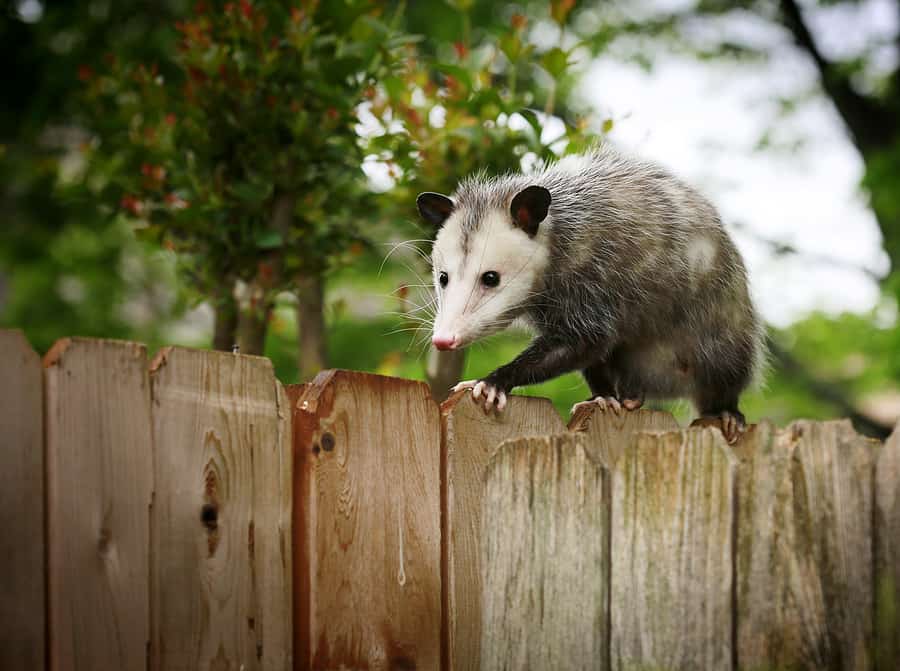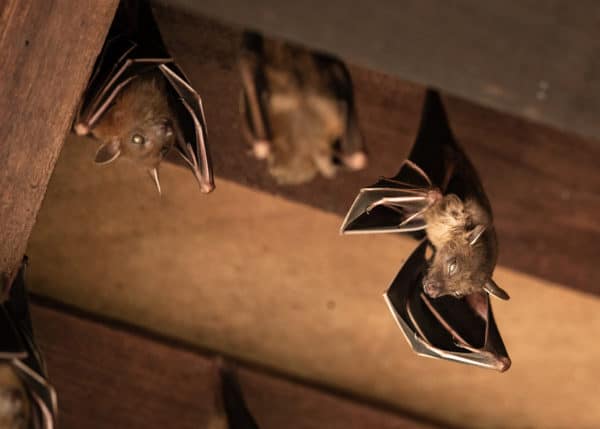READY TO GET STARTED?
REQUEST A FREE ESTIMATE
Fill out the form below or call (888) 466-7849 for a free, no-obligation estimate.

It’s minutes before you have to run out the door and make your commute to work. You make your coffee and look out the window, only to see last night’s dinner scattered throughout your yard! Unfortunately, your garbage has been rummaged through all night by a couple of wildlife pests. Two popular animals that are known to forage through trashcans and dumpsters for food are raccoons and opossums.
Raccoons, known for their distinctive black mask coloring on their faces, can range from just under 2 feet long to over 3 feet long. These animals are considered nocturnal and are rarely seen by humans. Be aware, though, spotting a raccoon during the day can be a possible sign they have rabies or other abnormal conditions.
Raccoons are scavengers, looking for food wherever they can find it, often foraging in trashcans and dumpsters. These skillful creatures can easily use their paws to open doors and lids to look for food. While they are omnivores, they prefer fruits and nuts over meat. Because they are creatures of habit, once these animals find a food source at your home, they will keep coming back until the food source is gone.
Another animal you’ll catch roaming around your trashcans is the opossum. Grey in color, opossums can range from 14” long to over 3 feet long, with their tails making up 50 percent of their total body length! These animals also tend to live near wet areas such as swamps and marshes.
While opossums are omnivores, they prefer insects and carrion over fruits and vegetables. As highly skilled climbers, you’ll find these creatures in trees, staying up there for as long as they can. They are also slow movers so don’t expect them to make a quick getaway! Opossums are generally not aggressive, though they will play dead if they are threatened.
Here are some tips to help prevent wildlife from rummaging through your garbage.

Nuisance wildlife is defined as any type of wild animal that invades a human habitat. This can include squirrels, skunks, opossum, raccoons, moles, voles, groundhogs, birds, bats, snakes, rodents, and more. Anytime a pest gets into your home the potential for damage and contamination is significant. That’s why it’s important to deal with the issue as soon as possible.
There are different ways to handle nuisance pests when they find a way into your home. Extermination involves killing the nuisance pest through the use of traps, toxins, and poisons. While this is generally cheaper and more efficient, the chemicals used can be dangerous for humans, pets, and other non-nuisance wildlife. Wildlife control involves the selective removal of problem populations of certain species of wildlife and usually employs the use of live traps or professional trappers to catch and relocate the nuisance pests to a safer habitat away from humans. This method usually takes longer than extermination and is more expensive. Wildlife exclusion is usually performed as a part of either of these wildlife services and involves preventative measures such as sealing up entry points and habitat modification (which ensures unwanted pests can’t access your property or structures).
Animal control services can be provided by your local government and is usually free although it is often selective in what types of animals they will service. Services provided and cost varies by area and municipality.
A professional wildlife control company will often combine wildlife control, exclusion and/or extermination methods depending on the type of pest you have. Whenever possible, humane control methods such as live removal and relocation are the preferred method of treatment.
Wildlife services typically range from $150 to $500 with the average visit costing between $250 and $250, although it can cost upwards of $1000 depending on what type of pest is involved and how much damage has already been caused. Most wildlife control companies will charge a flat fee or a minimum service fee (usually between $150 and $250), although some will also charge an additional hourly fee per hour after the first hour of service (anywhere from $25/hour to $250/hour depending on the service). This is determined by the type of pest problem, where it is located in the house, and what services are required (removal, exclusion, cleanup, etc). Raccoons and squirrels are usually the most expensive pests to service with an average of $200 to $1500 for a visit depending on the size of the infestation and the amount of damage inflicted. DIY traps can cost anywhere from $50 to $350.
In addition to fees for wildlife control services, damages caused by these nuisance pests is an often overlooked cost that should factor in to the overall budget. The longer you wait to get rid of the pest, the more damage that can occur. Nuisance pests can damage walls, chew through electrical wiring putting you at risk for fires, destroy insulation, and contaminate your home and HVAC system. Repairs for these issues including insulation replacement, wiring repair, drywall repair, duct repair, crawlspace cleaning and repair, and siding repair can be quite expensive and the cost can escalate quickly.
If you have a wildlife issue, contact a professional wildlife control company. A professional technician can inspect your home to determine what type of animal you are dealing with, the extent of the problem and damage, and appropriate ways to treat it. They can also provide you with wildlife exclusion techniques to help prevent repeat issues in the future. Professionals also guarantee their methods and are trained in the proper handling of wildlife, as well as the newest methods and techniques.
Is Mosquito Control Needed In Winter?
Where Did These Ants Come From?